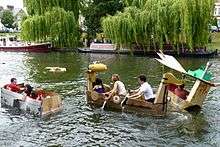Cardboard boat race


A cardboard boat race, sometimes known as a boat regatta, is a common school-spirit competition for students of high school and college age.
The earliest documented cardboard boat regatta was the result of a design problem created by Richard Archer at Southern Illinois University in 1974.[1]
A typical competition format allows competitors a fixed build time, using only a predetermined number of corrugated fiberboard sheets, glue, adding machine tape, and paint. Duct tape is also often a key ingredient.[2] Once completed, teams must race their boats across a shallow pond, river, or swimming pool using similarly constructed oars. The boats will almost always flood, sink, or shred under the weight, mostly owing to the difficulties of waterproofing cardboard.
In Rainy River, Ontario, races are held each year with simple rules. Purist Classes- Team registration includes a supply of all materials picked up at the same time to build your boat. Contestants must build the boats and compete the same day. Open classes- can be constructed prior to Race Day using cardboard, duct tape and additional adhesive components of the contestants choosing. Suitably themed and costumed participants are encouraged to enter their creations in the RailRoad Daze Parade. [3]
Cardboard boat building and races are becoming more commonplace. Cardboard Boat races are now held in many areas including on the Atlantic Ocean. Each year since 2005, brave souls have gathered at Champney’s West Newfoundland to create and race their cardboard boat creations in the cold waters of Trinity Bay on the North Atlantic. Many unique vessels made from cardboard pasted together with duct tape and painted in all types of designs and colors, have been launched into the harbor. All the brave sailors made their runs attempting to paddle their creations about a quarter mile, out to a buoy marker and back to the beach, without getting wet. Some made it while other crews capsized, got dunked or flooded, much to the amusement of the crowd.
See also
References
- ↑ MacLaren, Grant (December 30, 2007). "Cardboard Boats". grantmaclaren.com. Design Department: Southern Illinois University. Retrieved July 22, 2017.
- ↑ "Tips on Boat-Building". gcbr.com. The Great Cardboard Boat Regatta. Archived from the original on July 12, 2008.
- ↑ "Duct Tape and Cardboard Boat Races". railroaddaze.ca. Rainy River Railroad Daze. Archived from the original on June 20, 2011.
External links
- Pirate Fest- Las Vegas, Pirate Fest Las Vegas' Cardboard Regatta is sponsored by Zappos*The Great Beaver Boat Races Railroad Daze Rainy River, Ontario
- Erie, Pennsylvania's first-ever Cardboard Boat Regatta
- Cardboard Boat Races at Champney's West NL, racing cardboard boats in Trinity Bay Newfoundland.
- Great Cardboard Boat Regatta(R), which claims its 1974 founding race to be the first ever cardboard boat regatta.
- Cardboard Boat Race at McDonogh School
- Cardboard Boat race in Medford, Oregon
- Article about the Cardboard Boat Regatta in Stafford, Va.
- Cardboard Boat Regatta in Stafford, Va.
- The Cardboard Boat Book - The first book on how to build a cardboard boat
- CardboardCrew - All about cardboard races in Knoxville, TN
- Soap Kayak Race - Gara con canoe di cartone in Italy the longest cardboard boat regatta into the world
- Bathtub Derby Cardboard Boat race - St Maarten, Kimsha Beach annual boat race
- Go Fourth Festival Cardboard Boat Regatta in Longview, WA